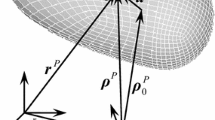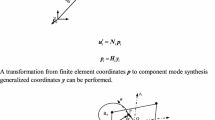Abstract
The impact dynamics of a flexible multibody system is investigated. By using a partition method, the system is divided into two parts, the local impact region and the region away from the impact. The two parts are connected by specific boundary conditions, and the system after partition is equivalent to the original system. According to the rigid-flexible coupling dynamic theory of multibody system, system’s rigid-flexible coupling dynamic equations without impact are derived. A local impulse method for establishing the initial impact conditions is proposed. It satisfies the compatibility conditions for contact constraints and the actual physical situation of the impact process of flexible bodies. Based on the contact constraint method, system’s impact dynamic equations are derived in a differential-algebraic form. The contact/separation criterion and the algorithm are given. An impact dynamic simulation is given. The results show that system’s dynamic behaviors including the energy, the deformations, the displacements, and the impact force during the impact process change dramatically. The impact makes great effects on the global dynamics of the system during and after impact.
Similar content being viewed by others
References
Schiehlen, W. Research trends in multibody system dynamics. Multibody System Dynamics, 18, 3–13 (2007)
Wang, D. T., Hong, J. Z., and Wu, T. H. Additional contact constraint method in impact stage of planar flexible multi-body dynamics (in Chinese). Chinese Journal of Theoretical and Applied Mechanics, 43(6), 1157–1161 (2011)
Schielhlen, W., Seifried, R., and Eberhard, P. Elastoplastic phenomena in multibody impact dynamics. Computer Methods in Applied Mechanics and Engineering, 195, 6874–6890 (2006)
Shabana, A. A. and Hussein, B. A. A two-loop sparse matrix numerical integration procedure for the solution of differential/algebraic equations: application to multibody systems. Journal of Sound and Vibration, 327, 557–563 (2009)
Ambrosio, J., Pombo, J., Rauter, F., and Pereira, M. A memory based communication in the cosimulation of multibody and finite element codes for pantograph-catenary interaction simulation. Multibody Dynamics: Computational Methods and Applications, 12, 231–252 (2009)
Klish, T. Contact mechanics in multibody systems. Multibody System Dynamics, 2, 335–354 (1998)
Eberhard, P. and Hu, B. Modern Contact Dynamics (in Chinese), Publishing House of Southeast University, Nanjing (2003)
Kim, S. W., Misra, A. K., Modi, V. J., and Cyril, X. Modeling of contact dynamics of two flexible multi-body systems. Acta Astronautica, 45(11), 669–677 (1999)
Lim, H. and Taylor, R. L. An explicit-implicit method for flexible-rigid multibody systems. Finite Elements in Analysis and Design, 37(11), 881–900 (2001)
Han, S. L. and Hong, J. Z. Multi-variable method for flexible multi-body systems with contact/ impact (in Chinese). Chinese Journal of Theoretical and Applied Mechanics, 43(5), 886–893 (2011)
Zhang, D. G. Recursive lagrangian dynamic modeling and simulation of multi-link spatial flexible manipulator arms. Applied Mathematics and Mechanics (English Edition), 30(10), 1283–1294 (2009) DOI 10.1007/s10483-009-1008-2
Liu, J. The Rigid-Flexible Coupling Dynamics for Flexible-Link and Flexible-Joint Robots (in Chinese), Nanjing University of Science and Technology Press, Nanjing (2006)
Dong, F. X., Hong, J. Z., Zhu, K., and Yu, Z. Y. Initial conditions of impact dynamics. Journal of Shanghai Jiaotong University, 15(3), 368–371 (2010)
Zhang, D. G. and Angeles, J. Impact dynamics of flexible-joint robots. Computers and Structures, 83, 25–33 (2005)
Khulief, Y. A. and Shabana, A. A. Dynamics of multibody systems with variable kinematic structure. Journal of Mechanisms, Transmissions, and Automation in Design, 108, 167–175 (1986)
Baumgarte, J. Stabilization of constraints and integrals of motion. Computer Methods in Applied Mechanics and Engineering, 1, 1–16 (1972)
Qin, Z. and Chen S. T. The negative exponential corrector for the mixed differential-algebra equations of the large deployable antenna of satellite (in Chinese). Journal of Xi’an Jiaotong University, 30(6), 88–92 (1996)
Author information
Authors and Affiliations
Corresponding author
Additional information
Project supported by the National Natural Science Foundation of China (Nos. 11132007, 11272155, and 10772085), the Fundamental Research Funds for the Central Universities (No. 30920130112009), and the 333 Project of Jiangsu Province of China (No.BRA2011172)
Rights and permissions
About this article
Cite this article
Duan, Yc., Zhang, Dg. & Hong, Jz. Partition method for impact dynamics of flexible multibody systems based on contact constraint. Appl. Math. Mech.-Engl. Ed. 34, 1393–1404 (2013). https://doi.org/10.1007/s10483-013-1754-7
Received:
Revised:
Published:
Issue Date:
DOI: https://doi.org/10.1007/s10483-013-1754-7




